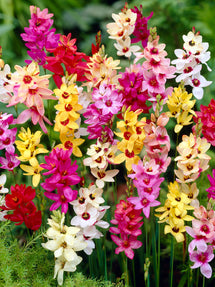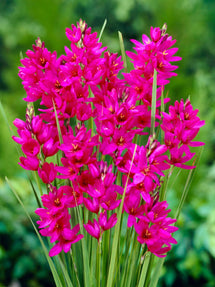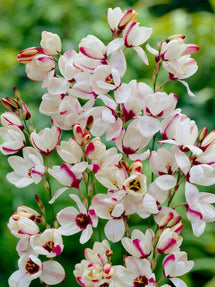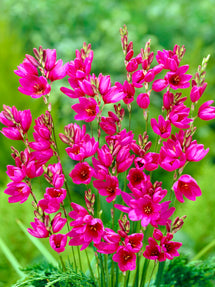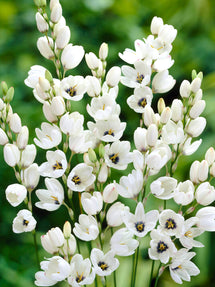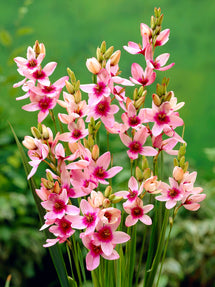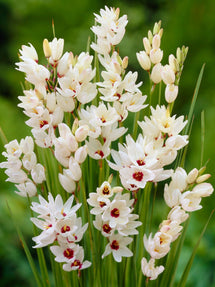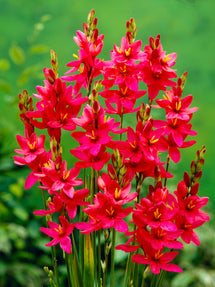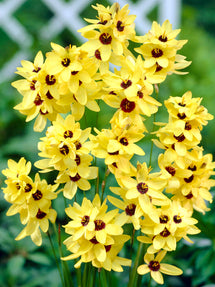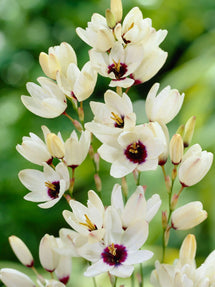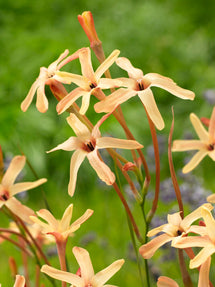Ixias
Transform Your Garden With The Dazzling Colours of Ixia Flowers
If you’re drawn to vivid hues, Ixia bulbs are the perfect choice. Flowering from late spring through early summer, these vibrant blooms are borne on long, wiry stems and display an array of star-shaped flowers. Select from an exquisite palette of whites, yellows, oranges, pinks, and reds to bring dazzling brilliance to your garden. Discover DutchGrown’s collection of top-sized Ixia bulbs (corms) to ensure robust growth and breathtaking results in your UK garden. With Ixia, you’re not merely planting flowers—you’re curating a season of enduring colour and charm.
Showing 1 - 12 in 12 items
African Corn Lily: A Bloom That Flourishes In Hot, Dry Conditions
Ixia, commonly known as the ‘African Corn Lily’ or ‘wand flower’, remains an underrated treasure in many gardens. These elegant plants produce tall, slender spikes adorned with cheerful, star-shaped flowers, each marked by a striking central eye. A single bulb offers an impressive display, often yielding multiple stems, each bearing up to 20 blossoms. Their graceful form makes them ideal for borders, flower beds, pots, and containers alike. Additionally, they are an excellent choice for cut flower arrangements. Ixia thrives particularly well in sunny, arid environments, such as those found in Southern Europe.
In addition to their vivid charm, Ixias are delightfully easy to grow and emit a light, pleasant fragrance that enhances any outdoor setting. Their vibrant blooms attract bees and butterflies, introducing a sense of movement and vitality to the garden. If you’re seeking a low-maintenance yet rewarding plant, Ixia is a reliable and beautiful choice.
Colourful Varieties: From Ixia Mabel to Ixia Hogarth
If you’re captivated by vivid hues, Ixia is a superb choice. Its eye-catching blooms appear in radiant shades of red, pink, purple, and yellow—perfect for injecting energy into your garden. Prefer a more understated palette? Ixia is also available in softer tones such as cream, white, and beige, ideal for creating a more refined and tranquil aesthetic.
- Ixia ‘Mabel’: This variety produces upright panicles adorned with long-lasting, star-shaped flowers in a vivid magenta hue.
- Ixia ‘Paniculata Eos’: This variety offers a charming display of soft apricot-yellow blooms.
- Ixia ‘Giant’: Notable for its elegance, ‘Giant’ features pure white petals highlighted by a distinctive blue central blotch.
- Ixia ‘Hogarth’: This Ixia variety showcases creamy-white, star-shaped flowers, each with a striking reddish-purple centre.
Can’t decide on a single colour? Opt for a mixed Ixia blend and delight in a vibrant, ever-changing palette throughout the flowering season.
How To Grow Ixia Bulbs For Maximum Effect In Your Garden
For the most impressive results, careful timing and placement are key when planting Ixia bulbs. As autumn-planted bulbs, Ixias should be set in the ground during the autumn months, ideally between September and November. Wait until the soil temperature falls to 15°C or below before planting to ensure optimal growing conditions.
Start by selecting a sunny spot with well-drained soil. Ixias thrive in full sun but can also tolerate partial shade. When planting, place the bulbs approximately 7–10 cm deep and space them 5–7 cm apart, ensuring the pointed ends face upwards. If planting in containers, you may group the bulbs more closely for a fuller effect, just be sure they do not touch one another. Once planted, water thoroughly just once, and then let nature take its course. If you live in a colder climate, be sure to overwinter your container-grown Ixias indoors, storing them in frost-free conditions during the colder months.
After your Ixia flowers have finished blooming, allow the foliage to yellow and die back naturally. This process enables the bulb to store energy in preparation for the next growing season. Looking for more advice? Follow the steps in our comprehensive guide, ‘How to Grow Ixia?’.
Explore Top-Quality Ixia Bulbs At DutchGrown
At DutchGrown, we offer a carefully curated selection of top-grade Ixia bulbs, chosen for their outstanding performance and vibrant colours. Each bulb is meticulously sourced to ensure you receive only the finest quality for your garden. Whether you're drawn to bold reds or soft creams, our range features striking varieties as well as beautifully blended mixes. Explore our collection and enjoy a flowering season filled with colour, character, and charm. We deliver across the United Kingdom.
Still not convinced? We would like to share 10 reasons why you should plant Ixias today.
Frequently Asked Questions About Ixia Bulbs
What Is The Common Name For Ixia?
Ixia is most commonly known as the ‘African Corn Lily’ or ‘wand flower’. The plant is a member of the Iris family (Iridaceae) and is native to South Africa’s Cape Provinces. Today, it is widely cultivated around the world as an ornamental garden favourite, cherished for its vivid colours and graceful form.
Where Is The Best Place To Plant Ixia?
Ixia flourishes in hot, dry climates. For optimal results, select a spot with full sunlight or partial shade and well-drained soil. This is crucial to prevent the bulbs from rotting. Perfectly suited to borders, flower beds, and containers, Ixia performs especially well in mild to hot climates. With the right placement, you’ll be rewarded each season with strong, upright blooms and a garden brimming with vibrant colour.
Is Ixia Easy To Grow?
Ixia is remarkably easy to grow and requires minimal care. Once planted in well-drained soil and a sunny location, these hardy bulbs will largely take care of themselves. Simply water them after planting and only give water when it hasn't rained for 3–5 days.
Does Ixia Come Back Every Year?
Ixias are generally treated as perennials and, with the right care and favourable growing conditions, they can return year after year. However, if you live in a region with cold winters, it's important to protect the bulbs from frost.
When Can I Plant Ixia Bulbs?
Ixia bulbs are best planted in autumn, once the soil temperature drops below 15°C, typically between September and November, depending on your climate zone. This timing allows them to establish strong roots and produce vigorous growth in the spring.
